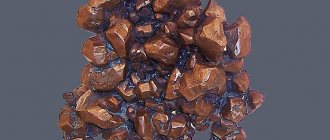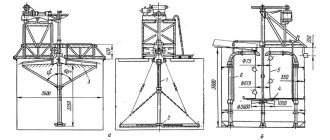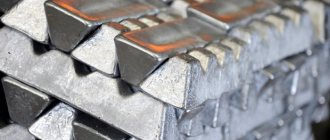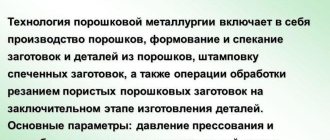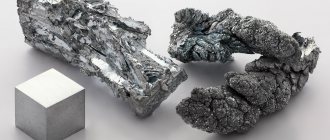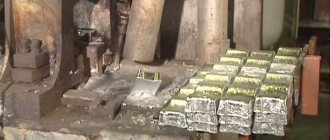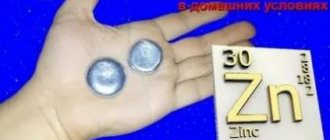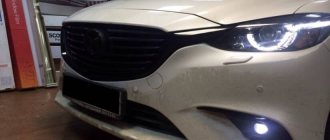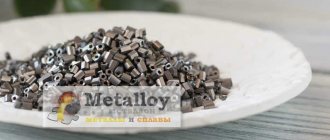Raw materials for zinc production
Zinc is obtained from sulfide ores, copper-lead-zinc, copper-zinc and lead-zinc. Sulfide minerals usually contain zinc in the form of sphalerite or wurtzite. In polymetallic ores it is contained along with minerals and elements. Sulfide polymetallic ores contain 1-3% zinc. Due to the complex composition of these ores, they must first be subjected to selective beneficiation to obtain several concentrates.
The most common is the hydrometallurgical method of zinc production, which is explained by the fact that this technology has a number of advantages over distillation. These benefits include:
- higher amount of extracted zinc and related substances
- complex nature of raw material processing
- high quality of obtained zinc
- high level of process mechanization
This method involves leaching zinc with a sulfuric acid solution from a calcined concentrate.
Zinc in industry
Zinc production technology
In nature, the metal occurs in the form of sulfide with impurities of copper, iron and cadmium. Zinc is not mined in its pure form. It is present in sulfide ores and mineral rocks: sphalerite, wurtzite, zincite. Also found in casting alloys with aluminum, copper (brass), and nickel.
Zinc is smelted at the plant. To produce zinc metal, pyrometallurgical and hydrometallurgical processes are used. Sulfide ores are processed, as a result of which they break down into individual elements: zinc and other components. The resulting zinc concentrate is roasted.
Characteristics of zinc: physical and chemical properties
The color of zinc is blue-white.
Melting point - 419°C.
Boiling point (turns into steam) - 913 ° C.
In a calm state it is a brittle metal (zinc density 7130 kg/m3).
Plasticity appears at 100°C.
The atomic mass of zinc is 65.382 amu.
Zinc forms oxygen compounds, oxidizes and forms a film.
Zinc does not react with alkalis and acids.
These properties make zinc a unique metal. At different temperatures it changes its state.
Applications of zinc
The main industrial uses of zinc are:
- Preparation of alloys with the addition of zinc;
- Production of galvanized steel;
- Zinc is the main alloying element for brass;
- Chemical production.
The metal is also widely used in other industries:
- This metal is used to extract gold and silver.
- Zinc is used to produce energy-intensive air and car batteries.
- Zinc is an important element in the creation of batteries.
- Zinc selenide is involved in the production of optical glasses.
- Used as an anti-corrosion material.
- Zinc sulfides and oxides are used to create flexible screens, car parts and weapons.
- The metal is used for the production of zinc matrices in the field of printing.
- Zinc sulfide detects radiation rays.
- Many paint mixtures for renovation contain zinc, especially white and white paint.
- In the production of household galvanized products: buckets, basins, dishes.
Methods for obtaining zinc
Zinc is extracted by two methods: pyrometallurgical (distillation) and hydrometallurgical (electrolyte).
Distillation method
This technology is based on roasting zinc concentrate in horizontal fireclay retorts, where sulfides are converted into oxides. Calcined zinc concentrate mixed with fine anthracite or coke breeze is loaded into retorts installed horizontally in the furnace. The heating temperature of the furnace is 1400 °C.
The mouth of the retort is connected to a condenser made of refractory clay, in which liquid zinc accumulates. Part of the zinc vapor that does not have time to condense enters an iron allonge placed at the mouth of the condenser.
When the distillation process ends, the condenser is removed and the sintered distillation waste - rimming - is unloaded from the retort.
This technology for producing zinc is quite simple, but its productivity is not high.
In addition, the resulting zinc contains lead and cadmium. Zinc is also obtained in vertical carborundum retorts, which are larger and have mechanized service.
A vertical retort has the form of a shaft with a rectangular cross-section. It is assembled from carborundum slabs or laid out from carborundum bricks.
On the sides of the retort there are chambers into which the generator gas that heats it is burned. The briquetted charge is loaded into the upper part of the retort, and the rimming is continuously unloaded from the bottom, also in the form of briquettes, which is preserved during the processing of the charge.
The thoroughly mixed mixture passes through a briquette press.
Then it is heated to 750–900 °C. This is accompanied by coking of coal and tar, as a result of which the briquettes become more durable and porous. The essence of the chemical distillation process in vertical retorts is similar to the technology implemented in horizontal retorts.
On average, a retort can be used for 3–5 years. It can produce 4–7 tons of zinc per day, or up to 90 kg per 1 sq. m of heat transfer wall.
Hydrometallurgical method for obtaining zinc
The electrolytic method for producing zinc also involves preliminary roasting of zinc concentrates followed by leaching with dilute sulfuric acid.
After the resulting solution of zinc sulfate is purified from impurities, its electrolysis is carried out. As a result, pure zinc is deposited on the cathodes, and oxygen is released at the anodes. And the solution is saturated with sulfuric acid, which can be used to leach the burnt concentrate again.
It is important that the amount of sulfuric acid coincides with its consumption for leaching the cinder. To fulfill this rule, the firing conditions are adjusted so that some of the sulfur remains in the cinder in the form of zinc sulfate, which does not require acid during leaching and the electrolysis that forms it.
Applications of zinc
To protect metals from corrosion
Pure zinc is used to protect metals from corrosion. The base is covered with a thin film. This process is called metallization.
In the automotive industry
Zinc-based alloys are used to decorate car interiors and in the production of door handles, locks, mirrors and windshield wiper housings.
Zinc oxide is added to car tires, which improves the quality of the rubber.
In batteries, accumulators and other chemical power sources, zinc is used as a material for the negative electrode. In the production of electric vehicles, zinc-air batteries are used, which have a high specific energy intensity.
In the production of jewelry
Jewelers add zinc to gold-based alloys. As a result, they are easy to forge and become plastic - they firmly connect small parts of the product to each other.
The metal also brightens jewelry, which is why it is often used in white gold.
Is zinc oxide dangerous for humans?
In accordance with GOST 12.1.007-76, zinc oxide has hazard class 2. The maximum permissible concentration in the air of the working area of industrial premises for it is 0.5 mgm3.
Whether the production of zinc oxide is dangerous or not depends on compliance with the rules for working with this substance. They require the use of personal protective equipment (Lepestok or UK-8 respirators, rubber gloves, safety glasses), as well as compliance with personal hygiene rules.
Premises where work with zinc is carried out must be equipped with general supply and exhaust ventilation. Places with the greatest amount of dust are equipped with local exhaust hoods. A fume hood should be used for laboratory analysis. Technological processes using zinc oxide must be carried out in sealed conditions.
contents .. 11 12 ..3.3.
Basics of Zinc Production
Zinc is a light gray metal with a bluish tint. In air, it is covered with a gray film of basic carbonate ZnCO3∙3Zn(OH)2, which is very dense and well protects zinc from further corrosion. The density of zinc at 20 °C is 7.14 g/cm3, the melting point is 419.4 °C, and the boiling point is 906 °C. Zinc is an electronegative metal (j°Zn/Zn2+ = –0.762 V) and dissolves in acids, releasing hydrogen. It also dissolves in alkaline solutions to form zincates. The melting point of zinc sulfide (ZnS) is 1650 °C, and zinc oxide (ZnO) is 1970 °C. Zinc forms alloys with many metals. World zinc production in 2004 was about 10 million tons.
Zinc is widely used to protect iron from corrosion (30-60% of total consumption in different countries). The most common alloys containing zinc are brasses and die casting alloys. Zinc oxide and sulfide are used as pigments.
The main natural zinc minerals are sphalerite ZnS and marmatite (Zn, Fe)S. Less common are oxide minerals: zincite ZnO, smithsonite ZnCO3, willemite Zn2SiO4, calamine Zn2SiO4∙H2O, etc. Accordingly, there are two types of zinc-containing ores: sulfide and oxide. In ores, zinc is almost always associated with lead, and often with copper. In sulfide ores, the main lead mineral is galena (PbS), and the copper mineral is chalcopyrite (CuFeS2). Sulfide ores are successfully enriched by flotation before metallurgical processing. Average chemical composition of zinc concentrates, which are the main natural raw materials for zinc production,%: Zn 45-60, Pb 0.1-3.0, Cu 0.2-3.0, Cd 0.1-0.5, Fe 5 -13, S 29-35, SiO2 0.4-4. Oxide ores go directly to metallurgical processing.
Processing of zinc sulfide concentrates.
Zinc sulfide concentrates can be processed using both pyrometallurgical and hydrometallurgical methods (see Fig. 2). Currently, more than 80% of total zinc production comes from hydrometallurgical technology.
Oxidative annealing
- the first operation in both methods of processing zinc concentrates - is aimed at converting zinc sulfide and sulfides of other metals into the form of oxides. The oxidation of metal sulfides releases a large amount of heat, which makes it possible to carry out the firing process without other energy sources.
The solid calcine product (cinder) sent for leaching must contain no more than 0.5% sulfide sulfur, up to 2-4% sulfate sulfur, have a particle size of the cinder generally no more than 0.15-0.2 mm, contain as much as possible less ferrites and zinc silicates. In modern industrial production of zinc, to obtain cinder of this quality, zinc concentrates are almost universally roasted in fluidized bed furnaces at temperatures of 900-1000 °C (most often at 930-980 °C). Factories use fluidized bed furnaces with a hearth area from 21-35 to 72-123 m2, in which 100-800 tons of concentrate can be fired per day, i.e. from 5 to 10-20 t/(m2×day).
The final product of concentrate firing for subsequent pyrometallurgical processing must be in the form of sufficiently strong and porous pieces ranging in size from 4-12 mm for smelting in electric furnaces and up to 20-60 mm for smelting in shaft furnaces, therefore agglomerating firing of the material is carried out, which may be preceded by firing " for powder."
Leaching cinder
is the second stage (see Fig. 2). The purpose of this process is to transfer as much zinc as possible from the cinder into solution and separate it from other components present in the cinder. To achieve these goals in practice, the cinder leaching process is carried out in one, two or more stages, among which in all cases there is a neutral leaching stage.
The main task of neutral leaching is the hydrolytic purification of the solution from iron and a number of other impurities; it is only possible to partially transfer zinc into the solution. The basis for hydrolytic purification of a solution from impurities is the difference in the equilibrium pH values of zinc hydrate formation and impurities (Fig. 17).
The zinc content in industrial solutions of zinc production is usually 130-180 g/l, and the final pH of the pulp during neutral leaching is 4.8-5.4. As follows from Fig. 17, at such pH values it is possible to clean the solution from Fe3+, Al3+, Cr3+ and partially from Cu2+. The ions Cd2+, Fe2+, Mn2+, as well as Ni2+ and Co2+ will remain in solution. To purify solutions from Fe2+, it is oxidized to Fe3+. During neutral leaching, As, Sb and some other impurities are precipitated along with Fe. To more completely transfer zinc into solution, the solid residue after neutral leaching is subjected to acid leaching, in which the final acid concentration in the pulp is 2-10 g/l (pH less than 1-2) or more. Along with the zinc, some of the impurities also pass into the solution. The temperature range for the pulp during the leaching process at atmospheric pressure is from 45 to 98 °C. Depending on the conditions and the number of leaching stages, the extraction of zinc from the cinder into the solution is 75-99%. Leaching is carried out in agitators with pneumatic or mechanical mixing of the pulp, in batch or continuous mode. The capacity of leaching devices is 40-100 m3 or more. To separate the pulp after leaching into liquid and solid parts, thickeners, frame and disk vacuum filters are used.
With non-firing technology, zinc concentrate is directly leached in an autoclave and goes into solution by reaction
ZnS + H2SO4 + O2 = ZnSO4 + H2O + S0.
Since a number of impurities still pass into the solution along with zinc, in addition to hydrolytic purification of impurities, the cementation method and the chemical method are used to remove them from the solution. Cementation is used to clean solutions from copper, cadmium, cobalt, and nickel, using zinc powder as a cementing agent. The chemical method is used to purify solutions from cobalt and chlorine ions. The composition of the zinc sulfate solution, purified from impurities, is as follows, mg/l: Zn (1.2-1.8)∙105, Mn (2-10)∙103, As 0.05-0.2, Sb 0.01 -0.15, Cd 0.1-2.0, Fe 0.2-50, Cu 0.05-0.1, Co 0.1-4.0, Ni 0.01-0.5, Cl– 20-300, F– 20-50. The solution is then sent for electrolysis.
Electrolysis is carried out
in rectangular bathtubs, the body of which in modern factories is made of reinforced concrete and coated on the inside with acid-resistant material. The cathodes are sheets of aluminum (titanium can also be used), and the anodes are plates of lead containing up to 1% silver. A neutral solution of zinc sulfate or its mixture with spent electrolyte is fed into the bath from one of the ends, and the spent electrolyte is drained from the opposite end of the bath. The total result of electrolysis can be represented by the reaction
ZnSO4 + H2O = Zn + H2SO4 + O2. (53)
Zinc is released at the anode, and oxygen is released at the cathode.
The spent electrolyte (like the entire solution in the electrolyte bath) contains 40-60 g/l Zn and 120-180 g/l H2SO4. The possibility of preferential release of electronegative zinc (joZn/Zn2+ = –0.762 V) rather than hydrogen (joH/H2+ = ±0) at the cathode is due to the high overvoltage (about 1 V) during the discharge of the hydrogen ion (hydronium ion H3O+) as zinc and aluminum, while the overvoltage during the discharge of zinc ions does not exceed 0.1 V. The magnitude of the overvoltage during the discharge of H3O+ at the cathode depends on the current density, the nature of the cathode surface, the presence of certain impurities in the electrolyte and its temperature in the bath (at in practice it is maintained within 35-40 °C). Impurities contained in the electrolyte can be divided into four groups: 1) cations that are more electropositive than zinc; 2) cations are more electronegative than zinc; 3) anions; 4) organic impurities. The anode is coated first with PbSO4 and then with PbO2, which prevent further rapid corrosion. The zinc released on the cathode is stripped off after 24-72 hours by removing the cathodes from the bath. Sheets of cathode zinc are melted in low-frequency induction furnaces to give them a marketable appearance. The electrolysis parameters of zinc sulfate solution are as follows: current density 300-700 A/m2; bath voltage 3-3.6 V; current efficiency 88-93%; electricity consumption is 2800-3300 kW∙h/t zinc.
With the hydrometallurgical method, the intermediate products are zinc cakes (residue after leaching of cinder), containing 16-23% zinc, and copper-cadmium cakes. The former are processed using pyrometallurgical (most often the Waelz process) or hydrometallurgical methods, the latter only hydrometallurgically.
Preparation of zinc by pyrometallurgical methods.
When producing zinc by the pyrometallurgical (distillation) method, the zinc-containing agglomerate is heated in a mixture with a carbonaceous reducing agent (usually coke) to a temperature of 1200-1400 °C, at which zinc oxide is reduced to free metal. Zinc in the form of steam (zinc boiling point 906 °C) along with other gases is removed from the furnace. When the gases are cooled, the zinc turns into a liquid state, resulting in rough zinc. The process of reduction of zinc oxide with carbon occurs, as a rule, in two stages according to the reactions
ZnO + CO Û Zn + CO2 – 67.7 kJ; (54)
CO2 + C Û 2СО – 172.4 kJ. (55)
The total reaction of this process
ZnO + C = Zn + CO – 240.1 kJ (56)
may partially occur directly. As already indicated, in accordance with Fig. 3, the thermodynamically minimum temperature for the reduction of ZnO with solid carbon is about 950 °C. In practice, the reduction of oxide zinc-containing materials using a solid carbonaceous reducing agent is carried out at 1100-1400 °C.
In modern practice, the production of zinc by the pyrometallurgical method is carried out by smelting zinc agglomerate mixed with coke and limestone in ore-thermal electric furnaces or by smelting lead-zinc agglomerate mixed with coke in shaft furnaces (Imperial Smelting Process).
Rough zinc can contain up to 1.2-4% impurities (1.1-3.5% Pb, 0.03-0.4% Cd, 0.02-0.3% Fe, etc.). Partial purification of zinc from lead and iron is carried out by segregation. The process consists of keeping zinc in small reverberatory furnaces (zinc capacity 30-150 tons) at 430-440 °C for 24-48 hours. To obtain zinc with a purity of 99.99% or more, a rectification process is used, based on the difference in boiling points zinc (906 °C) and impurities (cadmium 767 °C, lead 1750 °C, copper 2310 °C and iron 2450 °C). The process is carried out in distillation columns.
Fig. 17. Dependence of pH of precipitation (dissolution) of hydroxides
and basic salts of some metals in sulfate solutions
at 25 °C (the dashed line indicates the limiting pH value of zinc sulfate solutions with a zinc concentration of 100 g/dm3)
contents .. 11 12 ..
Global Zinc Consumer
Currently, China (“the world's factory”) is the No. 1 country in the production, consumption and processing of zinc. It is the world's largest producer of zinc, as well as its main consumer. Zinc consumption in China has tripled since 2000. China currently consumes more zinc than the US, Japan, India, and Europe combined.
To understand what will happen in the near future with zinc prices and its consumption, you just need to look at what China is doing now. The global factory needs zinc to produce cars, washing machines, factories, and infrastructure facilities. China is unable to produce enough zinc for its own needs and is forced to import it from other countries.
Zinc content in soil (zinc ores)
The zinc content in soil varies widely from 10 to 300 mg/kg, with an average of 70 mg/kg (0.007%). Weathering and erosion of rocks, soils and sediments naturally release small amounts of zinc into the environment. Water, air and soil have a natural concentration of zinc that can vary greatly depending on location.
In some parts of the world, natural geological and geochemical processes increase the zinc content to 5-15% (50,000 to 150,000 mg/kg). Rocks with such high zinc content are called ores. The ore is mined in the form of so-called zinc blende (ZnS), and is used in addition to zinc scrap as the most important raw material for zinc production. Zinc ores are found in many areas of our earth - in Canada, South Africa, Thailand, Brazil, Australia and China.
How big are zinc reserves?
The so-called “range” of zinc reserves is a dynamic value that depends primarily on global demand. As market shortages increase and zinc prices rise, mining companies are expanding their exploration activities.
Whenever zinc mines are discovered with enough zinc reserves to last at least 20 years of mining, exploration activity is curtailed. As a result, proven zinc reserves have remained constant since the 1960s.
Uses of zinc
The automotive industry consumes zinc to prevent corrosion of steel products and car bodies. Galvanizing is also used for the production of sheet metal, pipes, cables, construction, household appliances, batteries. In addition to protecting steel from corrosion, zinc is used:
- in automotive technology;
- in construction;
- in the production of household appliances, tools, toys;
- in pharmaceuticals and medical technology;
- in cosmetics;
- in the rubber industry;
- as a non-toxic white pigment in paint production;
- in fertilizers and animal feed.
Health Hazard
When heated or burned, it decomposes to form toxic gases: nitrogen oxides and zinc oxides. The substance is irritating to the eyes, skin and respiratory tract.
Inhaling dust can cause irritation to the nose and throat. Ingestion may cause irritation and corrosion of the digestive tract. In case of contact with eyes, it causes irritation to the cornea. Contact with skin causes irritation.
Respiratory system
Quantitative information on the systemic toxicity of zinc compounds is not available at this time. Elevated concentrations of zinc in the blood and urine of people exposed to smoke containing zinc oxide may indicate pulmonary absorption of hazardous substances, but more detailed studies are not available. In most of the reported cases, elevated serum zinc concentrations were not detected, even though significant toxic effects occurred.
Animal experiments show that inhaled zinc compounds can be absorbed anywhere in the respiratory tract. The degree of absorption probably depends on the clearance mechanisms in the relevant sections (nasopharynx, tracheobronchial region: trachea, bronchi or alveolar region). One study shows that about 5-18% of soluble zinc compounds (including zinc nitrate ) are absorbed in the nasopharynx, and about 13-50% in the tracheobronchial and alveolar regions.
It can be assumed that zinc is not absorbed in the respiratory tract due to its good solubility in water and the high degree of binding of zinc ions to proteins.
Leather
In vitro studies on human skin showed that zinc sulfate , which is readily soluble in water, absorbed less than 3% of the administered dose within 24 hours. The maximum superficial flow rate was 0.6 μg/sq.cm. Increased absorption was observed for damaged skin (blistering due to burns). Nitrate dust can dissolve in sweat and thus promote increased dermal absorption.
Gastrointestinal tract
In humans, depending on individual characteristics, the absorption of zinc ions from the digestive tract ranges from 8 to 80%. In people with high zinc stores, absorption is 20-30%. Absorption of zinc occurs throughout the small intestine through both passive diffusion and active transport mechanisms.
